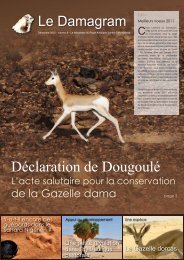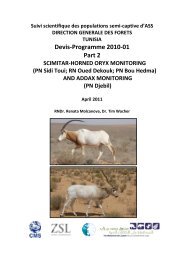The Biology, Husbandry and Conservation Scimitar-horned Oryx ...
The Biology, Husbandry and Conservation Scimitar-horned Oryx ...
The Biology, Husbandry and Conservation Scimitar-horned Oryx ...
Create successful ePaper yourself
Turn your PDF publications into a flip-book with our unique Google optimized e-Paper software.
43<br />
Part 2: <strong>Husb<strong>and</strong>ry</strong> Guidelines<br />
1968; Rice & Kalk, 1996). Dirt <strong>and</strong> fading may reduce the effectiveness of ear tags over time<br />
(Ashton, 1978) <strong>and</strong> numbers on some tags are difficult to read at a distance (Ulmer, 1968).<br />
Transponders<br />
<strong>The</strong> use of transponders for marking individual animals is increasing in popularity amongst<br />
EEP zoos. Transponders are quick <strong>and</strong> easy to apply, permanent <strong>and</strong> inconspicuous.<br />
Transponders are small, rod-shaped <strong>and</strong> encased in a glass capsule. <strong>The</strong>y range in size from<br />
2mm x 10mm to 3.5mm x 30mm with the smaller transponders having a range of less than<br />
8cm <strong>and</strong> the larger transponders having a range of 16cm. Each transponder is programmed<br />
with a unique code during manufacture <strong>and</strong> this code can then be read when a reader w<strong>and</strong> is<br />
waved over it (Rice & Kalk, 1996). Transponders are implanted under the skin or in the<br />
muscle, <strong>and</strong> once the implant site is cleaned with alcohol, infection is unlikely. However, due<br />
to the limited range of the transponder, implantation sites should be recorded <strong>and</strong> / or<br />
st<strong>and</strong>ardised for each animal (Rice & Kalk, 1996).<br />
However, the method may not be completely reliable <strong>and</strong> is usually used in conjunction with<br />
another, more visible, method of marking such as ear tags or notches.<br />
<strong>The</strong> disadvantages of using transponders for identification is that they are relatively expensive<br />
compared to other methods of marking, the performance is not always reliable <strong>and</strong> they need<br />
to be read in close proximity to the animal which usually entails physical restraint.<br />
Transponder systems are manufactured by different companies <strong>and</strong> are not all compatible<br />
with one another. When individual animals are transferred between institutions, the signal<br />
may not be detectable by the reader w<strong>and</strong> at the new institution. This lack of compatibility<br />
compromises the permanency of this marking technique (Rice & Kalk, 1996).<br />
With advances in technology it is likely that some of the concerns regarding the use of<br />
transponders such as the detectable distance will be overcome. For the time being the use of<br />
transponders offers a suitable backup to visual markings such as ear tags.<br />
Tattooing<br />
Tattooing is a traditional method for marking ungulates <strong>and</strong> is still used to identify individual<br />
oryx in some EEP zoos. Tattoos are inexpensive to apply (Rice & Kalk, 1996), should be<br />
permanent if applied correctly (Ashton, 1978; Rice & Kalk, 1996) <strong>and</strong> are inconspicuous,<br />
especially if the tattoo is applied to the inside lip or ear (Rice & Kalk, 1996).<br />
Numbered or lettered tattoos are applied using an electronic needle or tattoo pliers (Rice &<br />
Kalk, 1996; Ashton, 1978; Reuther, 1968; Ogilvie, 1968), <strong>and</strong> indelible green ink is<br />
preferable to black or red, as it contrasts well with the surrounding flesh colour (Ashton,<br />
1978; Reuther, 1968; Ogilvie, 1968). Tattoos should be applied to areas of skin with little hair<br />
where the number will be easy to read. This is commonly the ear (Rice & Kalk, 1996), but<br />
can include the axilla, medial thigh, ventral abdomen or chest, foot, inside the lip <strong>and</strong> inside<br />
the ear (Ulmer, 1968; Ogilvie, 1968; Reuther, 1968; Ashton, 1978).<br />
Tattoos can be applied shortly after birth as the animals are not difficult to capture <strong>and</strong> h<strong>and</strong>le<br />
at this time (Reuther, 1968). However, a delay of 24 – 48 hours may be advisable to give time<br />
for the mother-infant bond to develop (Rice & Kalk, 1996).





